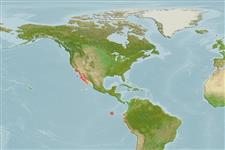分类 / Names
俗名 | 同种异名 | Catalog of Fishes(属, 种) | ITIS | CoL | WoRMS | Cloffa
Elasmobranchii
板鳃亚纲 (鲨鱼与 鱼) (sharks and rays) >
Heterodontiformes (Bullhead and horn sharks) >
Heterodontidae (Bullhead, horn, or Port Jackson sharks)
Etymology: Heterodontus: heteros (Gr.), different; odontos (Gr.), tooth, referring to pointy teeth (for clutching prey) at front of jaws, different than rounded molar-like teeth (for grinding hard-shelled invertebrates) at the back (See ETYFish); francisci: Of Francisco, probably referring to San Francisco (city and/or bay), California, USA (although its range does not extend that far north of its type locality, Monterey Bay) (See ETYFish).
Eponymy: The original description has no etymology but the specific name probably derives from the city of San Francisco (although the holotype was collected from Monterey Bay rather than San Francisco Bay). (Ref. 128868), visit book page.
More on author: Girard.
Environment: milieu / climate zone / depth range / distribution range
生态学
海洋 居于水底的; 深度上下限 0 - 152 m (Ref. 106604), usually 2 - 11 m (Ref. 9253). 亞熱帶的; 37°N - 15°S, 124°W - 75°W
Eastern Pacific: central California, USA to the Gulf of California, and probably Ecuador and Peru.
東太平洋: 美國加州中部到加州灣, 與可能厄瓜多與祕魯。
Length at first maturity / 大小 / 重量 / 年龄
Maturity: Lm ?, range 59 - ? cm
Max length : 122 cm TL 雄鱼/尚未辨别雌雄; (Ref. 247); common length : 97.0 cm TL 雄鱼/尚未辨别雌雄; (Ref. 247); 最大年龄: 12 年 (Ref. 72467)
Sluggish, nocturnal, and mostly solitary species. Inhabit rocky bottoms, kelp beds, sandy draws between rocks, on sand flats, deep crevices and small caves and also large underwater caverns. Adults tend to return to the same resting place every day (Ref. 43278). Feed on benthic invertebrates, especially sea urchins, crabs and probably abalone, also fishes. Oviparous (Ref. 50449). May bite back when harassed. Has broad muscular paired fins used as limbs for clambering on the bottom. Catch reduced to fish meal; fin spines used in production of jewels.
缓动性的,夜行的,与大部份独居性的种。 在沙地浅滩, 深的裂隙与小的洞穴以及大的在水中的巨穴上,栖息于岩石底部,海藻床 , 在岩石之间的沙平局。 成鱼倾向回到一样的休息每天放置.(参考文献 43278) 吃底栖的无脊椎动物, 尤其海胆, 螃蟹与可能鲍鱼, 也捕食。 卵生的.(参考文献 50449) 可能会咬人何时被攻击。 有在底部上爬行的肌肉宽阔的偶鳍当作四肢。 捕捉缩小成鱼粉了; 鳍棘被用于珠宝的生产了。
Life cycle and mating behavior
成熟度 | 繁殖 | 产卵场 | 卵 | 孕卵数 | 仔鱼
Oviparous (Ref. 205). Distinct pairing with embrace (Ref. 205). Courtship starts when the male chases the female, then when both are ready, they drop to the bottom (Ref. 43278). During courtship and prior to copulation, the male bites and wraps its body to the female pectoral fin, body, tail, and gills (Ref. 51127, 49562). The male then inserts a single clasper in the female's cloaca; copulation lasts 30 to 40 min. After one or two weeks later, the eggs are laid in about 11 to 14 intervals for 4 months which were deposited under rocks or in crevices, as was observed in nature. In captivity, the female drops the eggs on the bottom where the contents of the egg cases maybe eaten by these sharks; the eggs are hatched in 7 to 9 months. The young begin to feed one month after hatching (Ref. 43278).東太平洋: 美國加州中部到加州灣, 與可能厄瓜多與祕魯。
Compagno, L.J.V., 2001. Sharks of the world. An annotated and illustrated catalogue of shark species known to date. Vol. 2. Bullhead, mackerel and carpet sharks (Heterodontiformes, Lamniformes and Orectolobiformes). FAO Spec. Cat. Fish. Purp. 1(2):269 p. FAO, Rome. (Ref. 43278)
世界自然保护联盟红皮书 (Ref. 130435: Version 2024-2)
人类利用
渔业: 低经济; 水族馆: 公众的水族馆
工具
特别资料
下载 XML
网络资源
Estimates based on models
Preferred temperature (Ref.
123201): 15.9 - 23.7, mean 21.4 °C (based on 159 cells).
Phylogenetic diversity index (Ref.
82804): PD
50 = 0.5059 [Uniqueness, from 0.5 = low to 2.0 = high].
Bayesian length-weight: a=0.00437 (0.00235 - 0.00810), b=3.15 (2.98 - 3.32), in cm total length, based on LWR estimates for this species & (Sub)family-body (Ref.
93245).
营养阶层 (Ref.
69278): 3.2 ±0.3 se; based on diet studies.
回复力 (Ref.
120179): 低的, 最小族群倍增时间4.5 - 14 年 (Fec=20).
Fishing Vulnerability (Ref.
59153): High to very high vulnerability (73 of 100).
Nutrients (Ref.
124155): Calcium = 21.1 [4.1, 95.1] mg/100g; Iron = 0.68 [0.18, 2.01] mg/100g; Protein = 19 [17, 21] %; Omega3 = 0.201 [0.090, 0.442] g/100g; Selenium = 28.1 [8.6, 83.2] μg/100g; VitaminA = 7.36 [2.35, 22.58] μg/100g; Zinc = 0.646 [0.318, 1.171] mg/100g (wet weight);
